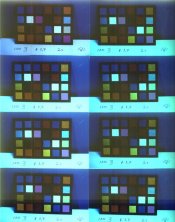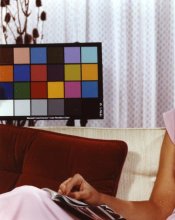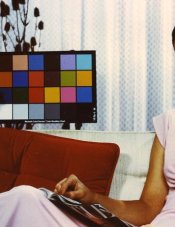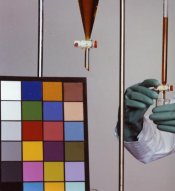Domin
Member
I spent some time trying to get reversal ra process. My success is rather limited.
I got image, but I cannot get white. Color balance is worse than I expected. The maximum 130y/130m on my Durst cls301 head is not enough to get rid of cyan cast. When added amber lighting gel I got neutral grays but then other colors were really off, greens and blues very dark, and all reds, yellows and even light magenta turned muddy red-brown. I could live with that as I did not expect accurate colors, but the lack of clear white is a problem. While I can get it neutral it's gray at best. To get white I need massive overexposure which ruins the rest of image. Overall contrast is low, almost all prints were made from rather contrasty slide of self made crude test chart.
All I know about my b&w developer is that its mostly hydroquinone with some phenidone. I prolonged time from standard 1min to 3mins. The developer made by local b&w lab/shop owner. I've used it for years now for prints. I don't know how secret is the formula. I'll going to ask him next week. At this point I didn't bother to get dektol as I had impression that PE used it not for unique properties but because it was his standard b&w print dev.
For RA I use two bath tetenal kit in trays.
The paper is Supra Endura III stored in room temperature for about 2 years.
I got some mottle. I've noted that mottle depends mostly on color. The worst is on light and mid cyan, there is some in blues, greens and a bit in reds. Its soft and big. Yellows and to lesser extent mageta gives pronounced grain.
Before trying reversal I tested paper and color kit on portra 160VC negative. The filter pack was about 80y 10m but I can compare the print only to digital print from a frontier which I naturally contrastier and more saturated.
Now I wonder what went wrong. Is it bw dev, dated paper which lost its red sensivity and is not correctable due to color crossover or is it the process itself and its matter of choosing images which would look ok with this problems.
I can post some scans later if it might be of any help of interest to someone. Just have to get my atrocious flatbed scanner from basement.
I got image, but I cannot get white. Color balance is worse than I expected. The maximum 130y/130m on my Durst cls301 head is not enough to get rid of cyan cast. When added amber lighting gel I got neutral grays but then other colors were really off, greens and blues very dark, and all reds, yellows and even light magenta turned muddy red-brown. I could live with that as I did not expect accurate colors, but the lack of clear white is a problem. While I can get it neutral it's gray at best. To get white I need massive overexposure which ruins the rest of image. Overall contrast is low, almost all prints were made from rather contrasty slide of self made crude test chart.
All I know about my b&w developer is that its mostly hydroquinone with some phenidone. I prolonged time from standard 1min to 3mins. The developer made by local b&w lab/shop owner. I've used it for years now for prints. I don't know how secret is the formula. I'll going to ask him next week. At this point I didn't bother to get dektol as I had impression that PE used it not for unique properties but because it was his standard b&w print dev.
For RA I use two bath tetenal kit in trays.
The paper is Supra Endura III stored in room temperature for about 2 years.
I got some mottle. I've noted that mottle depends mostly on color. The worst is on light and mid cyan, there is some in blues, greens and a bit in reds. Its soft and big. Yellows and to lesser extent mageta gives pronounced grain.
Before trying reversal I tested paper and color kit on portra 160VC negative. The filter pack was about 80y 10m but I can compare the print only to digital print from a frontier which I naturally contrastier and more saturated.
Now I wonder what went wrong. Is it bw dev, dated paper which lost its red sensivity and is not correctable due to color crossover or is it the process itself and its matter of choosing images which would look ok with this problems.
I can post some scans later if it might be of any help of interest to someone. Just have to get my atrocious flatbed scanner from basement.
















